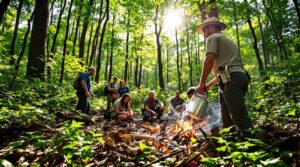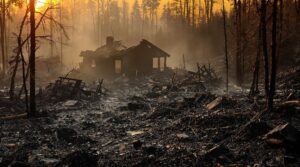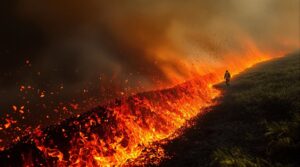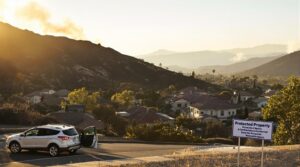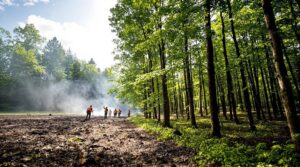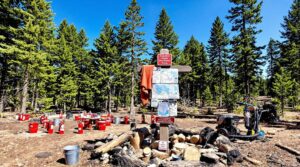Wildfires ignite when fuel, heat, and oxygen in the fire triangle interact, exacerbated by dry weather and flammable vegetation. Human activities, including discarded cigarettes and equipment, greatly contribute to wildfire outbreaks.
Fires spread through conduction, convection, and radiation, with wind and moisture levels influencing dynamics. Wildfires have substantial ecological and health repercussions, damaging habitats and impairing air quality.
Prevention involves creating defensible spaces and readiness plans. Discover more about their multifaceted impacts and mitigation strategies.
Key Takeaways
- Wildfires need heat, fuel, and oxygen; dry vegetation and drought increase ignition risks.
- Human activities, such as discarded cigarettes, account for most wildfire ignitions.
- Fire spreads through conduction, convection, and radiation, with wind and terrain significantly influencing its speed and direction.
- Wildfires cause ecological damage, leading to habitat loss, soil erosion, and biodiversity changes.
- Wildfire smoke impacts health, increasing respiratory issues and risks of chronic diseases due to particulate matter exposure.
Understanding The Basics Of Wildfires & Forest Fires
Understanding the fundamentals of wildfires involves examining the elements that make fires burn and the behavior and heat transfer methods inherent to such events. The fire triangle, consisting of fuel, heat, and oxygen, represents the essential components required for a fire’s ignition and persistence.
Analyzing fire behavior and heat transfer mechanisms such as conduction, convection, and radiation within this framework provides critical insights into wildfire dynamics. Wildfire Defense Services employs advanced technology systems, including satellite data and thermal sensors, to detect and track these fundamental fire behaviors in real-time.
| Fire Component | Description |
|---|---|
| Fuel | Flammable materials like vegetation |
| Heat | Energy source that ignites the fuel |
| Oxygen | Supports combustion processes |
What Makes Fires Burn
When examining the factors contributing to the ignition and spread of wildfires, the fire triangle provides a fundamental framework, consisting of fuel, oxygen, and heat. Fuel, as a flammable material, is vital in determining how a fire ignites and burns.
The moisture content in these fuels significantly affects fire behavior; drier conditions facilitate more rapid wildfire spread. Weather conditions, particularly high temperatures, low humidity, and strong winds, exacerbate the potential for fires to ignite and propagate swiftly.
Key factors include:
- Fuel Type: Trees, grasses, and shrubs.
- Moisture Content: Lower moisture leads to intense fires.
- Weather Conditions: High temperatures and winds.
- Terrain: Fires spread faster uphill.
- Flammable Vegetation: Certain plants enhance fire risk.
Understanding these elements is essential for comprehending wildfire dynamics. Creating a defensible space buffer of at least 30 feet around properties by removing flammable vegetation can significantly reduce wildfire risks.
Fire Behavior Fundamentals
Fire behavior, a critical aspect of understanding wildfires and forest fires, is dictated by several environmental and physical factors. The fire triangle—fuel, heat source, and oxygen—underpins ignition and progression.
Fuel, primarily vegetation and wood, varies in moisture content, greatly affecting fire behavior; dry fuels accelerate wildfire spread, while moisture-laden fuels slow combustion.
Weather conditions, including wind, temperature, and humidity, further modulate fire dynamics, with wind particularly enhancing spread by delivering oxygen and dispersing embers. Human activity remains a pivotal factor, responsible for 85% of ignitions in the U.S.
The following elements influence fire behavior:
- Fuel moisture content
- Weather conditions
- Topographic features
- Human activity
- Fire triangle components
Heat Transfer Methods
In the complex dynamics of wildfires and forest fires, heat transfer methods are pivotal in determining the fire’s behavior and progression. Conduction, convection, and radiation are key processes facilitating heat spread, leading to ignition and combustion of available fuel.
The fire triangle—comprising heat, fuel, and oxygen—illustrates that each component is indispensable for sustaining a fire.
Several factors influence these heat transfer methods:
- Conduction: Heat movement through solid materials like trees.
- Convection: Heat carried by air currents, spreading embers.
- Radiation: Emission of heat that ignites nearby combustibles.
- Wind: Enhances oxygen supply and disperses embers, intensifying spread.
- Moisture: Low levels in fuels increase susceptibility to ignition.
These mechanisms underscore the complexity of wildfire dynamics.
Natural & Human-Caused Wildfire Fire Triggers
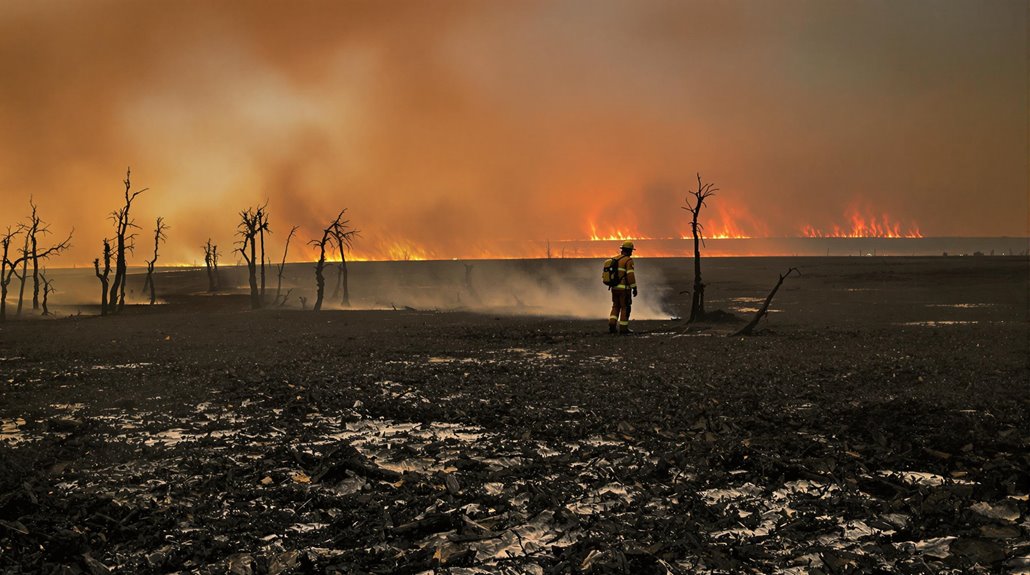
Wildfire ignition is influenced by both natural and anthropogenic factors, with lightning strikes being the principal natural trigger and human activities accounting for most incidents. Careless campfire management, vehicle sparks, and discarded cigarette ignition are significant human-induced fire causes, posing substantial risks, especially in arid conditions.
The table below provides a comparative analysis of these triggers, highlighting their prevalence and impact on wildfire occurrence. Homeowners in wildfire-prone regions often face high-risk insurance premiums due to increased catastrophic losses.
| Trigger Type | Example | Prevalence (%) |
|---|---|---|
| Natural | Lightning Strikes | 15 |
| Human-Caused | Careless Campfires | 30 |
| Human-Caused | Vehicle Sparks | 25 |
| Human-Caused | Discarded Cigarettes | 10 |
| Human-Caused | Other | 20 |
Lightning Strikes In Nature
Although natural forces play a significant role in igniting wildfires, lightning strikes are a notable natural trigger, especially in regions characterized by arid conditions. These strikes can rapidly ignite wildfires, with the risk amplified by drought conditions and abundant fuel sources.
Property owners facing wildfire exclusion risks should carefully review their insurance coverage to ensure adequate protection against lightning-triggered fires. As climate change affects weather patterns, increasing temperatures and prolonged dry spells may exacerbate this risk.
When a lightning strike occurs, the fire spreads swiftly, driven by:
- Drought conditions: Reducing moisture in vegetation, making it more combustible.
- Fuel sources: The type and amount of vegetation available to burn.
- Fire risk: Elevated in areas with high lightning activity.
- Climate change: Altering frequency and intensity of storms.
- Fire spreads: Facilitated by dry weather and high winds.
Understanding these dynamics is essential for managing wildfire risks.
Careless Campfire Management
Many wildfires result from careless campfire management, underscoring the critical need for stringent fire safety practices. Human-caused wildfires often originate from poorly extinguished campfires, increasing fire risk in vulnerable forested areas. To mitigate this risk, campers and outdoor enthusiasts must prioritize proper fire management techniques, such as thoroughly extinguishing fires before leaving a site. As wildfires rapidly spread and devastate large regions, they create wildfire hotspots around the world, prompting environmental and economic concerns. Education on fire safety can significantly reduce the occurrence of these destructive events, protecting both nature and communities alike.
*In California, 95% of fires are caused by humans, with campfires being a notable contributor.
To mitigate this fire danger, personal responsibility in fire protection is paramount. Attention to detail in extinguishing campfires can considerably reduce wildfire incidents.
Key practices include:
- Never leave campfires unattended.
- Fully extinguishing campfires with water.
- Stirring ashes until entirely cool.
- Adhering to fire danger regulations during high-risk periods.
- Emphasizing personal responsibility in fire safety.
These measures are critical in reducing the incidence of wildfires, thereby protecting both ecosystems and human infrastructure.
Proper wildfire safety measures are especially crucial given that wildfire risks affect approximately 2.6 million homes nationwide.
Vehicle Sparks & Heat
Igniting devastating consequences, vehicle sparks and heat are significant triggers for wildfires through both natural and human activities. Sparks can easily ignite dry vegetation when metal components of vehicles strike hard surfaces. This ignition risk is heightened by poorly maintained equipment, where overheated exhaust systems may encounter flammable materials.
In addition, the friction produced by chains dragged on unpaved roads or trails is a critical concern, leading to fires due to:
- Metal strike sparks: Vehicles striking hard surfaces can create sparks.
- Overheated exhaust systems: Poor maintenance increases fire risk.
- Chain friction: Chains dragging on the ground can spark fires.
- Agricultural machinery: Equipment in dry conditions can ignite fires.
- Human activities: Account for 84% of wildfires, largely due to vehicle-related sparks.
These factors underscore the critical role of human activities in exacerbating wildfire risks.
Discarded Cigarette Ignition
Despite being a small and often overlooked item, a discarded cigarette can serve as a formidable catalyst for wildfires, particularly in environments characterized by drought and low humidity.
These seemingly innocuous items can ignite dry vegetation, significantly contributing to wildfire risks. Human causes, primarily through careless disposal, account for approximately 85% of wildfires in the U.S., with discarded cigarettes frequently leading to accidental ignitions alongside unattended campfires.
During periods of increased dryness, the probability of ignition rises sharply, highlighting the need for vigilance, including:
- Discarded cigarettes which can easily ignite dry vegetation.
- Human activities which are major contributors to wildfire risks.
- Dryness and low moisture which heighten ignition potential.
- Unattended campfires & debris burning which are one of the most common causes.
- Proper disposal which is essential to minimize accidental ignitions.
Visual documentation of wildfire damage serves as crucial evidence when filing insurance claims for property losses caused by cigarette-induced fires.
The Science Behind WildFire Spread
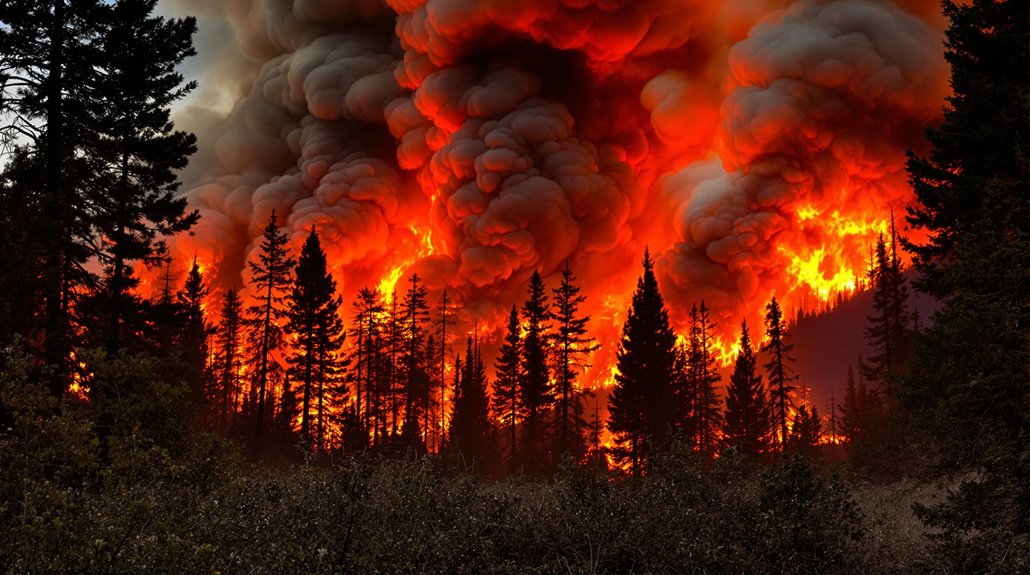
The intricate dynamics of wildfire spread are governed by the interplay of wind and weather patterns, fuel and vegetation types, and heat transfer mechanics. Wind is a vital driver, influencing the direction and speed of fire spread by enhancing oxygen supply and transporting embers.
The characteristics of vegetation, such as moisture content and density, interact with environmental conditions to dictate fire behavior through heat transfer mechanisms, where conduction, convection, and radiation play distinct roles.
| Factor | Influence on Spread | Mechanism Involved |
|---|---|---|
| Wind & Weather | Direction and speed of fire spread | Oxygen supply, ember transport |
| Fuel & Vegetation | Combustion intensity and rate | Moisture content, density |
| Heat Transfer | Fire behavior | Conduction, convection, radiation |
Wind & Weather Patterns
Understanding the role of wind and weather patterns is vital in analyzing the dynamics of wildfire spread. Wind acts as a catalyst, influencing wildfire behavior by supplying oxygen and dispersing embers, facilitating ignition and accelerating fire spread.
High temperatures and low humidity exacerbate this effect by drying out fuels, promoting rapid fire ignition. Weather patterns play an essential role, with lightning storms frequently serving as ignition sources in remote regions.
These elements collectively enhance wildfire propagation and complexity:
- Wind direction and speed dictate fire spread rate.
- Fires progress more swiftly uphill due to preheated fuels.
- South-facing slopes experience drier, warmer conditions conducive to burning.
- Strong winds can generate fire whirls, intensifying fire unpredictability.
- Peak afternoon temperatures greatly escalate fire intensity.
Fuel & Vegetation Types
Wind and weather patterns greatly influence wildfire behavior, but the type of fuel and vegetation present is equally pivotal in understanding wildfire spread. The nature of combustible material, such as dead and dry vegetation, including grasses and leaves, has significant implications for fire behavior.
Examples Include:
- Fuel loads: Denser vegetation types can facilitate rapid wildfire spread due to increased combustible material.
- Flammability: Certain plants, like oaks, have oils and resins, enhancing their flammability.
- Moisture content: Critical in determining fire ignition; low moisture leads to rapid ignition, while high moisture can slow burning.
- Vegetation types: Due to structural and chemical differences, coniferous forests and grasslands exhibit varying fire behaviors.
- Ignition potential: Dry conditions elevate ignition risks, impacting fire intensity and spread dynamics.
Heat Transfer Mechanics
As wildfires ravage landscapes, the underlying heat transfer mechanics reveal the intricate science behind their rapid spread. Central to this phenomenon is the fire triangle, highlighting the necessity of heat, fuel, and oxygen for ignition. During wildfire season, these elements combine to facilitate the transfer of energy through various mechanisms.
These mechanisms collectively explain wildfire dynamics & their devastating efficiency:
- Conductive heat transfer: Nearby flammable materials absorb heat, potentially reaching their ignition point.
- Convection: Warm air rises, creating currents that transport flames and embers to new areas.
- Radiant heat: Preheats surrounding vegetation, enabling ignition without direct flame contact.
- High temperatures: Accelerate heat transfer, intensifying the spread through dry, combustible materials.
- Low humidity: Further enhances the heat transfer rate, facilitating faster wildfire propagation.
Environmental Conditions That Fuel Wildfires
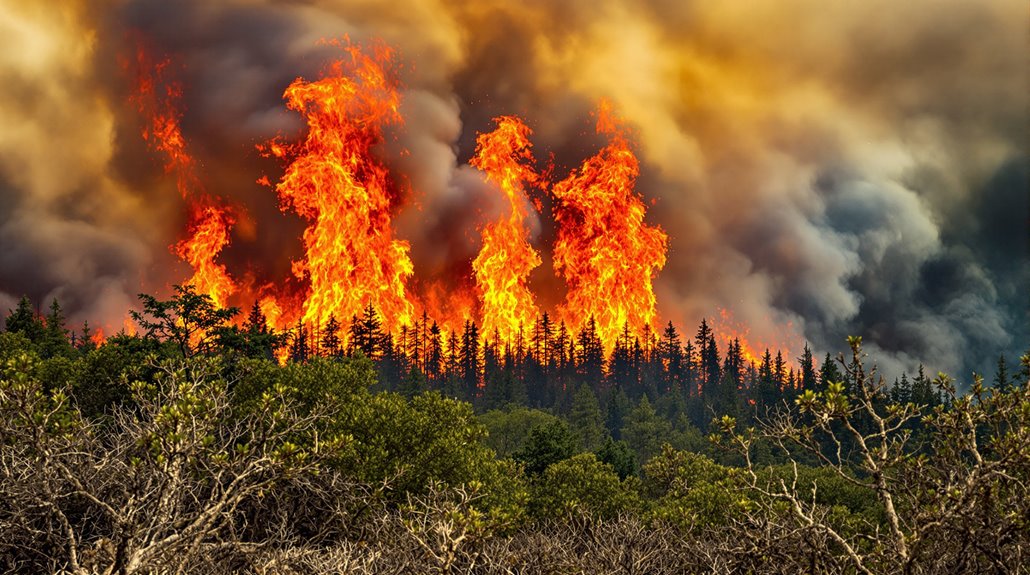
Environmental conditions play a critical role in escalating wildfires, with key factors including dry vegetation, strong wind patterns, and low humidity levels. These elements interact synergistically, creating a volatile setting where dry vegetation is abundant fuel, strong winds facilitate rapid fire spread, and low humidity exacerbates combustion.
The interplay between these conditions can be further examined through the following table, which outlines their impacts on wildfire dynamics:
| Environmental Factor | Impact on Wildfires | Resulting Effect |
|---|---|---|
| Dry Vegetation | Provides ample fuel for ignition | Increases fire intensity |
| Strong Wind Patterns | Enhances fire spread and ember transport | Leads to spot fires |
| Low Humidity Levels | Reduces moisture in fuels | Accelerates fire progression |
| Heat | Elevates temperature of fuels | Facilitates ignition |
| Topography | Influences fire direction and speed | Affects spread rate |
Dry Vegetation & Heat
Dry vegetation serves as a critical factor in the proliferation of wildfires, primarily due to its role as a ready fuel source. In hot, dry environments, the risk of wildfires increases substantially. Prolonged drought conditions lead to decreased moisture content, causing vegetation to wilt and dry, consequently becoming more susceptible to ignition.
The presence of low moisture content in dead grasses and leaves accelerates fire spread and intensity. Vegetation die-off, often resulting from extreme weather events, adds to the available dry fuel, further exacerbating wildfire risks.
These risk factors include:
- Hot, dry environments elevate wildfire risks.
- Prolonged droughts lead to vegetation drying.
- Low moisture content increases ignition potential.
- Extreme weather events contribute to vegetation die-off.
- Accumulation of dry fuels enhances wildfire spread.
Strong Wind Patterns
Strong wind patterns significantly contribute to the intensification and spread of wildfires by providing essential oxygen needed for combustion. These winds greatly influence fire behavior, complicating containment strategies, especially under high temperatures prevalent during fire seasons.
Local weather conditions that include strong winds heighten the risk of wildfires, as gusts propel embers far beyond the fire front, creating new ignition points and expanding the fire’s reach. Furthermore, the direction of wind patterns can lead to unpredictable fire spread, posing challenges for firefighting efforts when.
Understanding these dynamics is vital for mitigating wildfire impacts:
- Strong winds supply additional oxygen, accelerating combustion.
- Embers are carried ahead, igniting spot fires.
- Gusty conditions increase fire spread risk.
- Wind direction alters fire behavior unpredictably.
- Uphill wind accelerates fire spread in mountainous areas.
Low Humidity Levels
While wind patterns play a significant role in wildfire propagation, atmospheric conditions such as low humidity levels also critically influence wildfire behavior. Low humidity decreases the moisture content in vegetation, rendering it more flammable and increasing the likelihood of ignition and rapid spread of wildfires.
In environments where relative humidity drops below 30%, dry conditions become prevalent, facilitating fire growth when:
- Moisture retention in vegetation is compromised, leading to drier, more combustible fuels.
- High temperatures exacerbate low humidity effects, intensifying the drying of potential fuels.
- Rapid fire growth is often observed as low humidity conditions expedite ignition.
- Regions like the southeastern U.S. are less affected during humid summers, illustrating the protective role of moisture.
- Wildfires thrive under dry conditions, highlighting the critical nature of humidity management in fire prevention.
Impact On Wildlife & Ecosystems
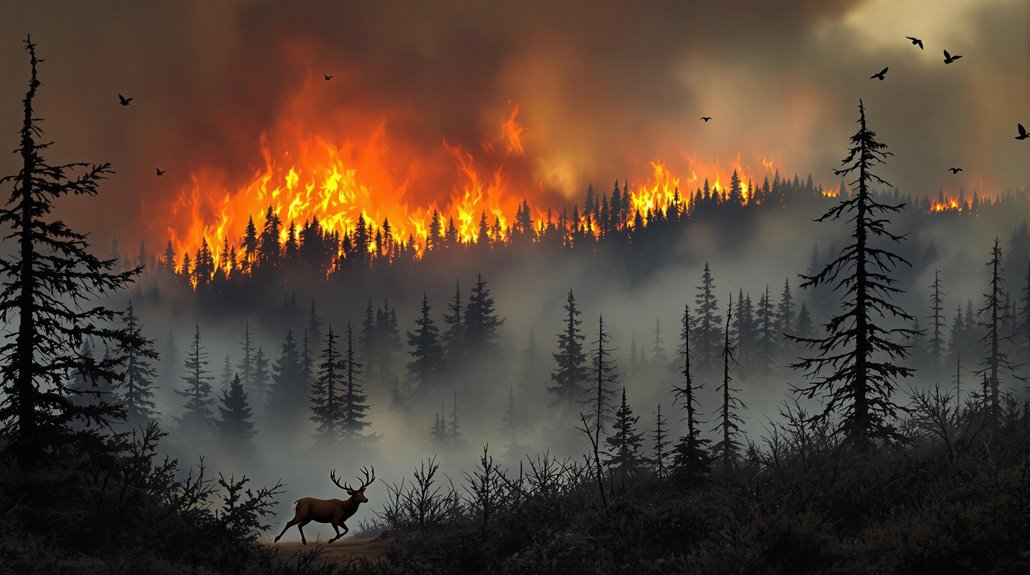
Wildfires profoundly impact wildlife and ecosystems, primarily through habitat loss and displacement, posing significant challenges for species population recovery. The destruction of vegetation disrupts the food chain, affecting both herbivores and predators, while the intensity of fires can lead to long-term ecological changes.
These effects are systematically illustrated below:
| Impact | Consequence | Example |
|---|---|---|
| Habitat Loss | Displacement of species | Habitat fragmentation |
| Population Recovery | Difficulty in species resurgence | Reduced breeding grounds |
| Food Chain Disruption | Altered predator-prey dynamics | Changes in species diet |
| Soil Erosion | Increased habitat degradation | Loss of nutrient-rich soil |
| Ecosystem Alteration | Shift in species composition | New dominant species |
Habitat Loss & Displacement
The impact of wildfires on wildlife and ecosystems is profound, as these events often lead to significant habitat loss and displacement of animal populations. Wildfires consume vegetation, essential for food and shelter, substantially disrupting ecosystems.
Consequences of these ecological disturbances include:
- Displacement of wildlife that depends on specific vegetation for sustenance.
- Soil erosion, exacerbated by the absence of plant roots, leading to further habitat degradation.
- Increased vulnerability to mudslides in affected regions, posing additional threats to the remaining wildlife.
- The release of carbon stored in vegetation contributes to climate change and alters habitats.
- Prolonged recovery periods for ecosystems can span decades, causing extended displacement and stress on animal populations.
These elements underscore the intricate relationship between wildfires and environmental stability.
Species Population Recovery Challenges
In the aftermath of wildfires, species population recovery faces formidable challenges, largely due to the extensive habitat destruction these fires cause. The loss of vegetative cover leads to severe soil erosion, further complicating the recovery of terrestrial and aquatic habitats.
Key challenges include:
- Destruction of habitats critical for species populations, affecting their survival and reproduction.
- Loss of food sources essential for sustaining wildlife, resulting in decreased population viability.
- Prolonged recovery periods due to adverse post-wildfire conditions, such as drought.
- Initial nutrient release benefits overshadowed by long-term habitat destruction.
- Fragmentation of ecosystems hindering effective wildlife recovery.
These factors collectively reduce reproductive success and hinder the ability of affected species to rebound, posing significant ecological challenges in post-wildfire scenarios.
Food Chain Disruption Effects
As wildfires ravage landscapes, they precipitate a profound disruption in local food chains, which can have cascading effects on wildlife and ecosystems.
Habitat destruction eliminates shelters and food sources, leading to significant population declines among numerous species. This disruption results in ecological changes and biodiversity loss, as interdependent relationships within food chains are altered.
Key plant species may be obliterated, depriving herbivores of essential resources and triggering further imbalances. Additionally, erosion exacerbates these effects by impeding plant regrowth, which is vital for ecosystem recovery.
The presence of toxic chemical residues from burned materials can contaminate surviving vegetation and further endanger wildlife populations through:
- Habitat destruction: Loss of shelter and food sources.
- Food chains disrupted: Key species perish or migrate.
- Population declines: Species suffer significant decreases.
- Ecological changes: Altered species interactions and dependencies.
- Erosion: Compromises plant regrowth and ecosystem resilience.
Health Risks & Air Quality Concerns
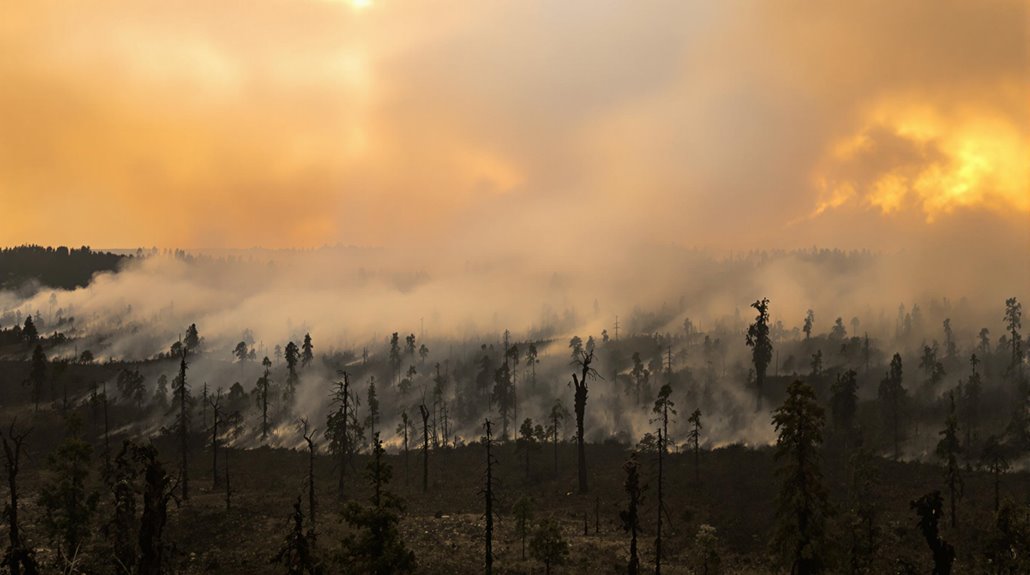
The impact of wildfires on air quality poses significant health risks, particularly concerning respiratory issues and long-term health complications. Particulate matter and harmful pollutants can infiltrate indoor environments, necessitating strategies to protect indoor air quality.
The table below outlines key pollutants and their associated health effects:
| Pollutant | Health Effects |
|---|---|
| Particulate Matter (PM2.5) | Respiratory irritation, lung function |
| Carbon Monoxide | Headaches, reduced oxygen transport |
| Volatile Organic Compounds | Throat irritation, exacerbation of asthma |
| Nitrogen Oxides | Respiratory problems, lung inflammation |
Respiratory Issues During Wildfires
Wildfire smoke poses significant health risks due to its complex mixture of pollutants, which include particulate matter (PM2.5), carbon monoxide, and volatile organic compounds. These pollutants exacerbate respiratory issues such as asthma and bronchitis by impairing lung function.
According to the Environmental Protection Agency, PM2.5 can travel vast distances, degrading air quality even far from the fire source. Health advisories often recommend protective measures, especially for vulnerable groups like children and the elderly.
Health Risks & Advisories Include:
- Respiratory Issues: Increased incidence of asthma and bronchitis.
- Air Quality: PM2.5 affects distant regions, leading to poor air conditions.
- Health Advisories: Guidelines emphasize staying indoors and using air filtration.
- Lung Function: Decreased due to inhalation of smoke pollutants.
- Hospital Admissions: Rise in respiratory-related cases during wildfires.
Long-Term Health Complications
While the immediate respiratory challenges posed by wildfire smoke are evident, the potential for long-term health complications remains a significant concern. Prolonged exposure to this smoke can lead to persistent respiratory issues, such as chronic obstructive pulmonary disease (COPD) and aggravated asthma, particularly affecting vulnerable groups like children and the elderly.
Toxic pollutants in wildfire smoke pose risks for cardiovascular diseases, as fine particulate matter (PM2.5) can impair air quality over extended periods. Understanding these risks is vital for public health strategies.
The health implications include:
- Increased rates of hospital admissions for respiratory conditions
- Potential development of lung cancer and other pulmonary diseases
- Long-distance travel of smoke affecting far-reaching communities
- Deterioration of air quality impacting overall public health
- Sustained presence of harmful pollutants contributing to chronic diseases
Protecting Indoor Air Quality
Even as wildfires rage outdoors, maintaining indoor air quality becomes a critical concern to safeguard public health. Smoke from wildfires in the U.S. can infiltrate buildings, posing significant health risks, particularly to vulnerable populations.
This smoke contains particulate matter that exacerbates respiratory conditions and elevates pollution levels. Consequently, proactive measures are essential to mitigate these effects.
Effective air quality management during wildfires is crucial for reducing health risks, such as:
- Use air purifiers equipped with HEPA filters to reduce particulate matter indoors.
- Seal windows and doors to prevent smoke infiltration.
- Monitor air quality using reliable sources to stay informed of changing conditions.
- Limit physical activity indoors to reduce inhalation of pollutants.
- Create a clean room with minimal smoke exposure for sensitive individuals.
Climate Change & Wildfire Intensity
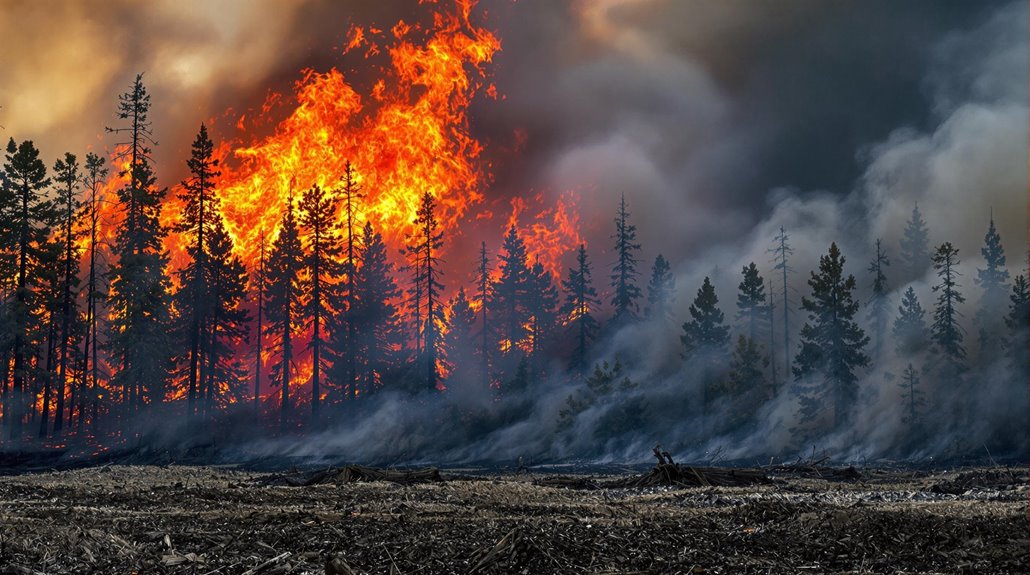
The intensification of wildfires is closely linked to climate change, as rising global temperatures create conditions conducive to more frequent and severe fires.
Extended fire seasons, driven by prolonged periods of higher temperatures and reduced precipitation, further exacerbate the risk of wildfire outbreaks. The relationship between drought and fire is intensified, with drier landscapes providing ample fuel for ignition.
| Factor | Impact on Wildfires | Resulting Consequences |
|---|---|---|
| Rising Global Temperatures | Increased frequency and severity | More intense wildfire events |
| Extended Fire Seasons | Longer duration of fire-prone periods | Greater cumulative fire risk |
| Intensified Drought-Fire | Abundant dry fuel sources available | Rapid spread and escalation |
Rising Global Temperatures Impact
A significant factor contributing to the increasing intensity and frequency of wildfires is the rise in global temperatures, which has profound implications for wildfire behavior and management. These factors collectively intensify the challenges in managing wildfires, as the conditions they create increase the likelihood and severity of fires, complicating containment efforts and amplifying ecological consequences.
Rising global temperatures lead to:
- Drought conditions: Extended periods without rainfall result in hotter and drier environments.
- Flammable vegetation: Dry conditions create abundant fuel for wildfires.
- Increased frequency: Climate change exacerbates severe weather patterns, resulting in more frequent wildfires.
- Ecological impacts: Large amounts of carbon dioxide and carbon monoxide are released into the atmosphere.
- Hotter and drier: Higher average temperatures contribute to environments that are more conducive to ignition.
Extended Fire Seasons
Numerous studies have demonstrated that climate change has considerably extended fire seasons globally, intensifying wildfire activity and severity. The start of fire seasons now occurs earlier, driven by fire weather conditions characterized by less moisture and elevated temperatures.
This scenario enables large wildfires to spread more aggressively due to drier ecosystems:
- Less moisture: Reduced precipitation leads to drier soils and vegetation.
- Fire weather: Increased temperatures and strong winds exacerbate fire conditions.
- Trees and plants: Desiccated flora becomes a significant fuel source.
- Large wildfires: The frequency and size have risen with prolonged fire seasons.
- Spread: Enhanced climate conditions facilitate more rapid fire propagation.
These factors collectively underscore the critical impact of climate change on extending fire seasons and increasing wildfire intensity.
Drought-Fire Relationship Intensifies
Building on the understanding of extended fire seasons, the intensifying relationship between drought and wildfire underlines the significant role of climate change in elevating wildfire intensity. Drought conditions lead to the wilting and drying of vegetation, transforming it into flammable vegetation, which serves as fuel for wildland fires.
Climate change exacerbates hotter areas by prolonging fire seasons and increasing the frequency and intensity of wildfire. The southeastern U.S. often illustrates this phenomenon, experiencing heightened wildfire risks following droughts.
The ecological impacts are profound, with severe alterations to landscapes and ecosystems. In high-risk regions, homeowners face elevated insurance rates due to the increased likelihood of fire-related damage.
Critical Factors Include:
- Rising temperatures contribute to drier soil moisture.
- Prolonged droughts create ideal conditions for ignition.
- Increased greenhouse gas emissions occur during wildfires.
- Hotter areas face longer, more intense fire seasons.
- Flammable vegetation heightens risk of wildland fires.
Prevention & Safety Measures
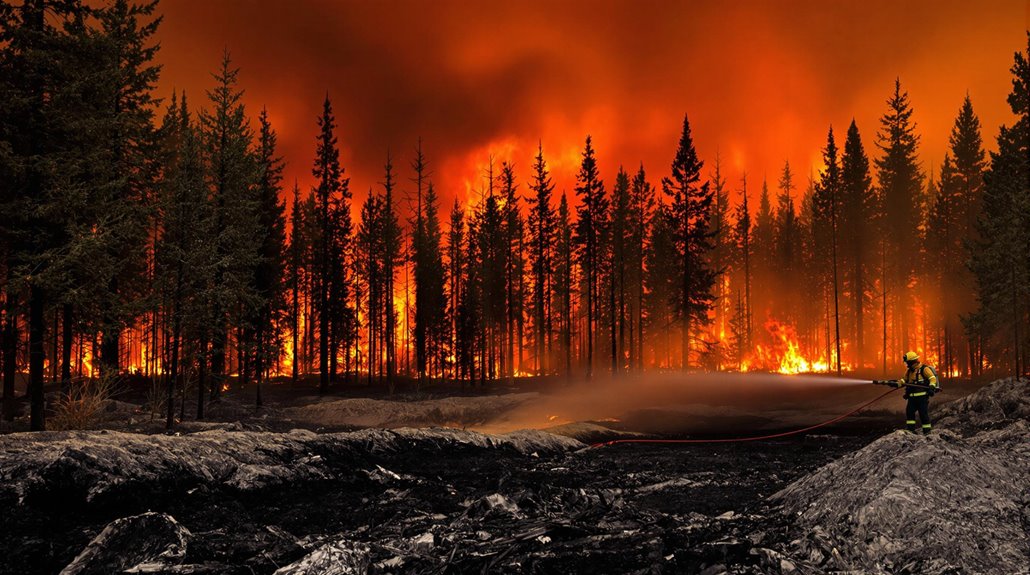
In addressing wildfire prevention and safety measures, a focus on creating defensible space around properties, establishing thorough evacuation plans, and preparing emergency supplies is paramount.
A defensible space involves strategic landscaping and removal of flammable materials to reduce fire risk, while evacuation plans must be detailed and practiced regularly to guarantee readiness.
Moreover, emergency supply kits should be meticulously assembled to include essentials for survival in the event of displacement, as outlined in the table below.
| Prevention & Safety Measure | Key Element Details |
|---|---|
| Defensible Space | Landscaping and debris removal |
| Evacuation Plan | Practiced routes and communication |
| Emergency Supplies | Food, water, first-aid kit |
| Community Education | Workshops and resources |
| Firewise Site Collaboration | Joint risk assessment |
Creating Defensible Space
Establishing a defensible space is critical in wildfire prevention and safety measures, providing a scientifically validated buffer zone that considerably reduces the risk of fire encroachment on structures.
Creating defensible space involves removing flammable vegetation and dead plants to reduce wildfire risk. Within this defensible zone, maintaining at least 30 feet clear of potential fire fuel is essential.
Utilizing fire-resistant landscaping and prescribed burns can further mitigate the risk by limiting fire spread.
Key strategies include:
- Trimming tree branches to maintain a 10-foot distance between trees.
- Removing dead plants and debris regularly.
- Ensuring structures have non-combustible materials.
- Mowing grasses and raking leaves to eliminate ignitable materials.
- Implementing non-flammable plant species to enhance landscape resilience.
These measures are crucial in safeguarding property from wildfires. Experts recommend creating three distinct defensible fire zones, extending from 0-5 feet, 5-30 feet, and 30-100+ feet from your home for maximum protection.
Evacuation Plan Essentials
While creating defensible space is a proactive measure to reduce wildfire risk, developing a thorough evacuation plan is essential for guaranteeing safety during an emergency. A well-structured evacuation plan minimizes risks associated with wildfires by addressing critical safety aspects.
These strategies guarantee preparedness and enhance safety:
- Multiple routes: Identify several escape paths to circumvent congestion and enable a quick evacuation.
- Safe meeting place: Designate a secure location outside the danger zone for family members to regroup if separated.
- Essential items: Keep important documents, medications, and emergency supplies readily accessible.
- Communication plan: Use text messaging to maintain contact during emergencies, reducing network congestion.
- Regular updates: Frequently practice and revise the evacuation plan to incorporate changes in circumstances, such as new routes or updated emergency contacts.
Emergency Supply Preparation
A thorough emergency supply kit is a cornerstone of preparedness in mitigating wildfire risks. This kit should be designed with both immediate and long-term needs in mind, guaranteeing readiness for potential evacuation scenarios.
Essential components include:
- Non-perishable food and water supplies for sustenance.
- Important documents, such as identification and insurance policies, stored in a waterproof container.
- A communication plan for family members to maintain contact and coordination.
- Medications and a first-aid kit for health maintenance.
- A battery-operated or hand-crank radio to receive updates from local authorities.
Regularly updating this kit every six months guarantees that food remains fresh and medications are effective. Such meticulous preparation enhances safety and facilitates recovery post-wildfire.
Recovery & Restoration After Wildfires

The recovery and restoration process after wildfires encompasses several key strategies, including natural regeneration, post-fire habitat management, and soil stabilization. Natural regeneration relies on the intrinsic ability of certain plant species to sprout and seed after fire events, which aids in ecosystem recovery.
Effective post-fire management practices are critical in maintaining biodiversity and preventing further soil erosion, as illustrated in the table below.
| Strategy | Objective | Example Techniques |
|---|---|---|
| Natural Regeneration | Promote ecosystem self-recovery | Seed dispersal, sprouting |
| Post-Fire Habitat | Preserve biodiversity | Controlled grazing, replanting |
| Soil Stabilization | Prevent erosion and mudslides | Mulching, silt fences |
| Monitoring | Assess recovery progress | Wildlife surveys, soil tests |
Natural Regeneration Process
Natural regeneration following wildfires is a complex process that involves the gradual recovery and restoration of ecosystems through various ecological mechanisms. This process is facilitated by fire-adapted plants capable of regrowth from seeds that respond to heat or smoke.
Post-fire, soil fertility often improves due to the release of nutrients from burned organic matter, enhancing conditions for new vegetation growth. Ecosystems benefit from increased biodiversity, as diverse habitats emerge from the mosaic of burned and unburned areas.
These elements collectively drive ecosystem recovery:
- Fire-adapted plants: Essential for regenerating vegetation.
- Soil fertility: Boosted by nutrient release, promoting plant growth.
- Nutrient availability: Supports the regrowth of varied plant species.
- Diverse habitats: Created by the heterogeneous post-fire landscape.
- Ecosystem resilience: Enabled by natural regeneration processes.
Post-Fire Habitat Management
Effective post-fire habitat management is essential to facilitate ecological recovery and restoration following a wildfire. This process involves thoroughly assessing the damage and strategic actions to restore ecosystems.
Key components include:
- Soil stabilization: Employing techniques like planting cover crops to prevent erosion.
- Restoring ecosystems: Reintroducing native vegetation, which is vital for reestablishing biodiversity.
- Monitoring wildlife: Tracking species populations to understand ecological impacts and adjust management plans.
- Strategic use of prescribed burns: Implementing controlled fires post-recovery to manage regrowth and reduce fuel loads.
- Prioritizing recovery efforts: Focusing resources on areas with the highest potential for successful rehabilitation.
These measures collectively aim to rehabilitate habitats over time, ensuring long-term ecological balance and resilience. For severely damaged properties, consulting restoration specialists can provide crucial expertise in assessing structural damage and implementing appropriate recovery strategies.
Soil Stabilization Methods
Post-fire habitat management encompasses a range of strategies, among which soil stabilization methods play a pivotal role in ecological recovery. Critical to erosion control, these methods facilitate vegetation recovery and ecosystem restoration.
Implementing hydroseeding, for instance, provides a rapid means to stabilize soil structure by applying a mixture of seed, mulch, and water, promoting moisture retention and vegetation growth.
Furthermore, using organic materials like wood chips helps improve soil structure and moisture retention. The employment of straw bale barriers and erosion control mats is essential in preventing soil erosion. In addition, replanting native plants enhances soil stabilization and supports ecosystem restoration.
Various methods contribute to the effective rebuilding of post-fire landscapes:
- Hydroseeding
- Straw bale barriers
- Erosion control mats
- Organic barriers
- Replanting native vegetation
The Role Of Fire Management Strategies
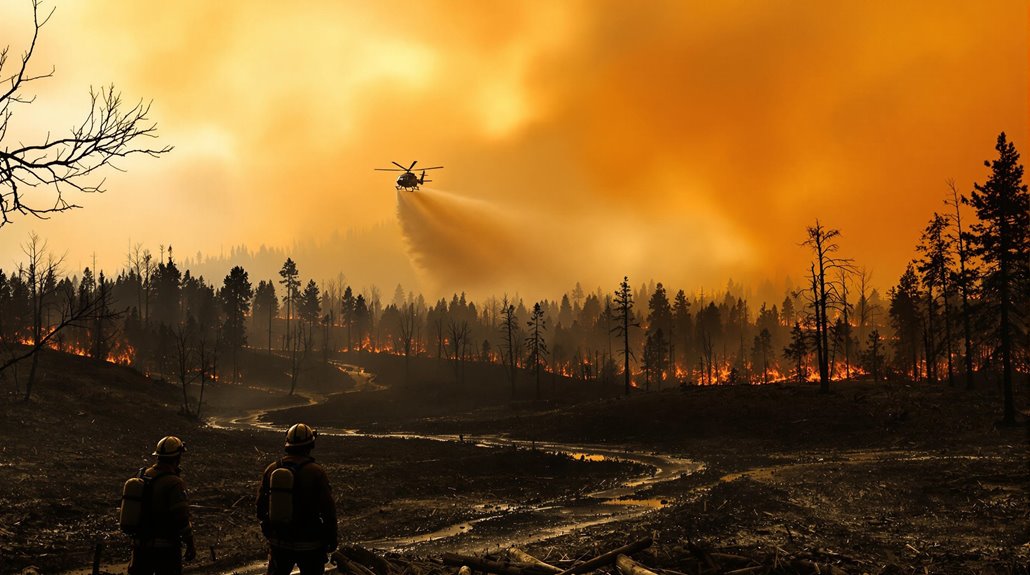
Fire management strategies are critical in mitigating the destructive potential of wildfires, focusing on proactive and reactive measures. Prescribed burns are systematically utilized to eliminate excess vegetation, thereby reducing fuel loads and decreasing the likelihood of severe fire incidents; meanwhile, early detection systems enhance prevention by enabling prompt response actions.
Strategic firefighting deployment guarantees resources are effectively allocated to protect both human life and critical infrastructure.
| Strategy | Purpose |
|---|---|
| Prescribed Burns | Reduce fuel loads, decrease fire severity |
| Early Detection | Enhance prevention through prompt response |
| Strategic Deployment | Maximize resource allocation |
| Community Engagement | Educate and promote collective action |
Prescribed Burns Save Lives
Prescribed burns, integral components of fire management strategies, are essential in mitigating wildfire risks and enhancing forest health. By intentionally using prescribed fire, agencies effectively reduce flammable vegetation, decreasing the likelihood of severe wildfires.
Key Benefits Of Prescribed Burns Include:
- Forest health is improved as these burns recycle nutrients and encourage the growth of fire-adapted species.
- Biodiversity is enhanced, fostering a more resilient ecosystem.
- Firebreaks are created, providing vital barriers to slow or stop the progression of wildfires.
- Catastrophic wildfires are less likely to occur, protecting both natural landscapes and human infrastructure.
- Communities benefit from reduced wildfire risks, safeguarding lives and properties.
Research supports that strategic prescribed burns are essential in reducing the incidence and impact of uncontrolled wildfires. With fire insurance coverage becoming increasingly critical, prescribed burns help minimize the risk of devastating property losses in high-fire-risk areas.
Prevention Through Early Detection
In the complex landscape of wildfire management, the early detection of fires emerges as a critical component in minimizing their spread and subsequent impact.
Efficient monitoring systems can identify fires in their nascent stages, allowing for timely intervention. Technologies such as remote sensing and satellite imagery are crucial in spotting wildfire hotspots, providing essential data for emergency responders.
Fire management strategies, including prescribed burning and forest thinning, are integral in reducing fuel loads, thereby enhancing ecosystem resilience. Community engagement is essential in these efforts, fostering awareness and collaboration with local agencies.
Key practices include:
- Implementing advanced monitoring systems
- Utilizing remote sensing for hotspot identification
- Engaging community in surveillance programs
- Conducting prescribed burns
- Thinning forests to manage fuel loads
Strategic Firefighting Deployment
Effective wildfire management hinges on strategically deploying firefighting resources, a critical facet of thorough fire management strategies. Strategic firefighting deployment utilizes natural or artificially constructed firebreaks to hinder the spread of fires by eliminating fuel sources.
Prescribed burning, a key method employed by agencies like the US Forest Service, mimics natural fires, thereby reducing fuel accumulation and enhancing forest health. This planned burning decreases wildfire risks and prevents crown fires by maintaining reduced vertical fuel continuity.
Additionally, vigilant monitoring of natural fires guarantees prompt intervention before they escalate. These strategies, coupled with community engagement initiatives like Firewise, are essential in promoting effective forest management and safeguarding residential areas from the destructive potential of wildfires.
Final Thoughts
Despite humanity’s advanced mastery over technology and nature, the irony lies in our struggle to control the wildfires we often ignite. While we endeavor to mitigate their spread through scientific understanding and fire management strategies, we simultaneously exacerbate their frequency and intensity through climate change and land-use practices. Consequently, the flames we seek to extinguish continue to demonstrate our paradoxical existence: creators of both destruction and attempted salvation in the natural world.
For homeowners facing property damage from wildfires, insurance industry professionals and legal experts strongly advise consulting a qualified state-licensed public adjuster for insurance claims. Public adjusters work exclusively for policyholders, not insurance companies, serving as dedicated advocates throughout the claims process.
These state-licensed professionals help navigate complex insurance policies, identify hidden damages often unknown to policyholders, document losses comprehensively, and negotiate with insurance companies to ensure fair settlements while protecting policyholder rights.
By engaging a public adjuster, homeowners can maximize their claim payouts, expedite the claims process, and reduce the stress of dealing with insurance companies during recovery.
For a no-obligation free consultation about wildfire-related property damage or loss claims, contact a Public Claims Adjusters Network (PCAN) member public adjuster through our contact page.
Frequently Asked Questions
How Do Wildfires Spread?
Wildfires spread through the interplay of fuel, weather, and topography. Low moisture fuels, wind-driven oxygen supply, and rising heat on slopes accelerate fire propagation. Vegetation with high oil content further intensifies and hastens the fire’s advance.
What Are the Causes and Effects of Wildfires?
Wildfires ignite through lightning’s fierce sparks or human negligence, fueled by dry winds and parched landscapes. Their aftermath includes charred ecosystems, polluted air, and altered climates, presenting challenges in restoration and profound impacts on biodiversity and human health.
What Causes 90% of All Fires?
Approximately 90% of all fires are attributed to human activities, encompassing unattended campfires, discarded smoking materials, and intentional acts like arson. These anthropogenic factors greatly outweigh natural causes, such as lightning, in contributing to fire ignition and spread.
Which of the Following Influences How a Wildfire Will Spread?
The dance of flames across landscapes is dictated by fuel availability, wind speed and direction, topography, and moisture levels. Each element acts like a conductor, orchestrating fire’s symphony, determining its speed, intensity, and direction.

